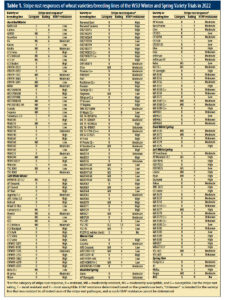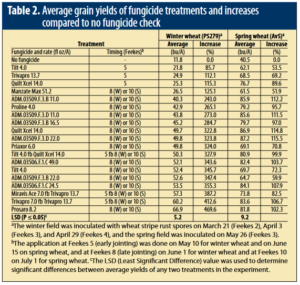By Xianming Chen
Stripe rust is one of the most destructive diseases of wheat, and barley stripe rust is also destructive in the Pacific Northwest (PNW). These two diseases are caused by different forms of the same fungal species. The degree of stripe rust damage is determined by the disease pressure, the levels of susceptibility or resistance to the disease in planted varieties, and the weather conditions. The diseases can be controlled through appropriate farming practices, planting resistant varieties, and using fungicides as needed.
Considering farming practices in stripe rust management, the general recommendation is using the best practices for the highest possible yield; avoid planting winter crops too early and planting spring crops too late; avoid excessive fertilizer; and avoid excessive irrigation.
Planting resistant varieties is the most effective, economic and environment-friendly approach to controlling stripe rust. Our research program has worked together with all public and private breeding programs to develop wheat and barley varieties resistant to stripe rust. Each year, we evaluate thousands of breeding lines for response to stripe rust. The nurseries from individual
breeding programs are evaluated at Pullman in Eastern Washington, Mount Vernon in Western Washington, and recently, at Central Ferry under irrigation.
The field stripe rust data is used by individual breeding programs to eliminate susceptible materials and select materials for moving forward into the variety trial nurseries for further testing on diseases, yield, quality and other traits, or further improvement through crossing and selection. We collaborate with the Washington State University (WSU) Variety Testing Program for evaluating materials in the winter and spring variety trials of wheat and barley. The variety trial nurseries contain commercial varieties currently grown in the PNW and most advanced breeding lines from public and private breeding programs. We evaluated these nurseries in more field locations, including Lind and Walla Walla, in addition to the above mentioned places. Based on the field data, each entry receives R (resistant), MR (moderately resistant), MS (moderately susceptible), or S (susceptible) category rating and a numeric rating in a 1 (most resistant) to 9 (most susceptible) scale. The numeric ratings for currently growing varieties are used in the seed buying guides as “stripe rust rating” for growers to select varieties.
In addition to the multiple-location field testing, we also test the variety trial nurseries under controlled greenhouse conditions using predominant races of the stripe rust pathogen in the seedling stage at the low-temperature profile (40-68 F) and in the adult-plant stage at the high-temperature profile (50-86 F). The data of the greenhouse testing allow us to determine if a variety or breeding line has one of two types of resistance or both: all-stage resistance, which is race-specific, and high-temperature adult-plant (HTAP) resistance, which is nonrace specific. Greenhouse testing data also allow us to determine the level of HTAP resistance. For breeding lines in the nurseries, the stripe rust category and numeric ratings, as well as the detailed stripe rust data in terms of infection type and severity in the field and greenhouse tests, are used to make decisions for releasing new varieties.
 As an example, Table 1 shows the stripe rust summary for the wheat varieties and breeding lines in the 2022 WSU winter and spring wheat variety trial nurseries. In general, varieties receiving stripe rust ratings 1 or 2 do not need fungicide application under any levels of stripe rust epidemics, while those with ratings of 3 or more may or may not need fungicide application depending upon disease pressure. For releasing new varieties, the lower the stripe rust rating, the better, but the lines with ratings 5 to 6 should be carefully considered, whereas 7 to 9 should be avoided completely.
As an example, Table 1 shows the stripe rust summary for the wheat varieties and breeding lines in the 2022 WSU winter and spring wheat variety trial nurseries. In general, varieties receiving stripe rust ratings 1 or 2 do not need fungicide application under any levels of stripe rust epidemics, while those with ratings of 3 or more may or may not need fungicide application depending upon disease pressure. For releasing new varieties, the lower the stripe rust rating, the better, but the lines with ratings 5 to 6 should be carefully considered, whereas 7 to 9 should be avoided completely.
Varieties with stripe rust ratings 3 or higher have differences in yield loss under different levels of epidemics. To determine potential yield losses from stripe rust and increases of individual varieties, every year we conduct experiments with 23 winter and 23 spring wheat varieties selected based on their planting acreage in previous years, plus a susceptible check, in each nursery. The varieties were randomly arranged in a split-plot design with sprayed and nonsprayed plots side by side with four replications. Each crop nursery consists of 192 plots.
Each plot was observed for stripe rust severity four to five times, starting just before the fungicide application at early jointing to soft dough stage. Grain test weight and yield were measured at harvest. Average values of relative Area Under the Disease Progress Curve (rAUD-PC), which was calculated from the multiple-time stripe rust severity data; test weight; and yield were compared between the sprayed and nonsprayed plots for each variety. The yield difference was used to determine the yield loss from stripe rust and yield increase by fungicide
application and used to rate fungicide response (FR, not included in Table 1 but available online
). Varieties with FR 0 do not need fungicide application, and those with FR 2 or higher need fungicide application, while those with FR 1 may or may not need fungicide application depending upon potential profits. As examples, the summary data of the 2022 winter and spring wheat nurseries are available online.
Under the severe stripe rust created by artificial inoculation with stripe rust pathogen spores, winter wheat WB4303 and UI Magic were rated FR 8 and 6 respectively. Nine varieties with yield losses of approximately 34% to 10% were rated FR 5 to 2, which need fungicide application. Nine varieties that received a FR 1 rating may or may not need fungicide application. Varieties Bruehl, Northwest Duet and M-Press with insignificant yield differences of only 0.3 to 3.7 bushels per acre, rated FR 0, should not need fungicide application. The 18 varieties rated FR 5 to 1 can be found on our stripe rust website online).
In the spring wheat yield loss nursery, 15 varieties received FR 0; six varieties received FR 1; and only two varieties (WB-1036CL+ and WB6341) were rated FR 2 or 3. The 21 varieties rated FR 0 or 1 can be found in the website mentioned above. The relative yield loss values are useful to determine the potential yield losses of the commercially grown varieties as our stripe rust predictions are made for susceptible varieties.
If susceptible varieties or varieties without an adequate level of resistance are grown, a fungicide can be used to prevent or reduce yield losses. Different fungicides can be selected based on their effectiveness and cost. Every year, we evaluate new fungicides and commercially used fungicides for their efficacy in control of stripe rust. Such data are used by chemical companies to register new fungicides and by growers to select fungicides for application in their fields.
 Table 2 shows the grain yields of various fungicide treatments in comparison with no-fungicide checks on both winter and spring wheat. Prosaro applied at 8.2 fl oz/acre at growth stage Feekes 8 and Trivapro applied at 7.0 fl oz/acre and again at 13.7 fl oz/acre at Feekes 8 increased yields by more than 400% in the winter wheat experiment. In the spring wheat experiment, Quilt Xcel (14.0 fl oz/acre) and new fungicides ADM.03509.F.3.B (11.0 fl oz/acre) and ADM.03509.F.3.D (either 11.0 or 22.0 fl oz/acre), applied at Feekes 10 produced over 110% more grain than the nontreated check. Based on our previous tests, fungicides effectively controlling stripe rust on wheat are also effective in controlling stripe rust on barley.
Table 2 shows the grain yields of various fungicide treatments in comparison with no-fungicide checks on both winter and spring wheat. Prosaro applied at 8.2 fl oz/acre at growth stage Feekes 8 and Trivapro applied at 7.0 fl oz/acre and again at 13.7 fl oz/acre at Feekes 8 increased yields by more than 400% in the winter wheat experiment. In the spring wheat experiment, Quilt Xcel (14.0 fl oz/acre) and new fungicides ADM.03509.F.3.B (11.0 fl oz/acre) and ADM.03509.F.3.D (either 11.0 or 22.0 fl oz/acre), applied at Feekes 10 produced over 110% more grain than the nontreated check. Based on our previous tests, fungicides effectively controlling stripe rust on wheat are also effective in controlling stripe rust on barley.
For the 2023 crop season, our current prediction based on the weather data from November 2022 to February 2023 is 37% on highly susceptible varieties, an increase from the January prediction of 21%, but still in the same range of a moderate epidemic level. Potential yield losses of commercially grown varieties are predicted as 0 to 27% based on the relative yield loss value. According to the current forecast, fields grown with winter wheat varieties with stripe rust ratings 6 to 9 in the seed buying guide or with relative yield loss of 16% may need fungicide application and varieties with ratings 0 to 5 may not need fungicide application. We will conduct rust surveys and provide updates and recommendations throughout the crop season. For timing fungicide application, please check fields. If active rust pustules are observed, apply fungicide before rust incidence reaches 5%.
Cultivar Resistance & Yield Loss Data
This article originally appeared in the April 2023 issue of Wheat Life Magazine.

Xianming Chen, Ph.D.
Xianming Chen is a research plant pathologist with the USDA-ARS and an adjunct professor at Washington State University. His research interests include foliar diseases of wheat and barley, especially rusts. He also works on epidemiology and control of rusts, including cultural, chemical, and disease resistance. His work contributes to the development of models for predicting rust epidemics. Read more about Dr. Chen.
